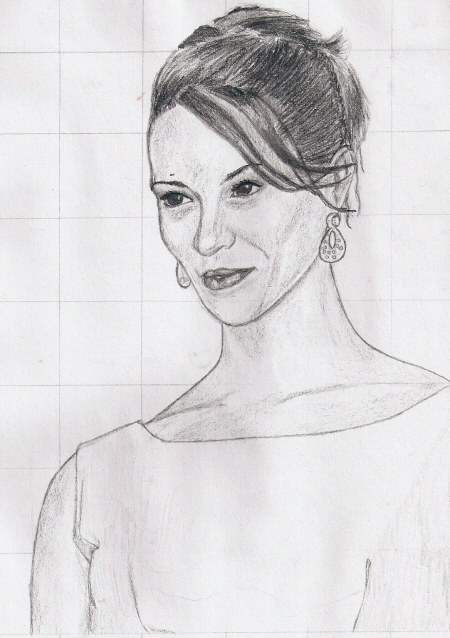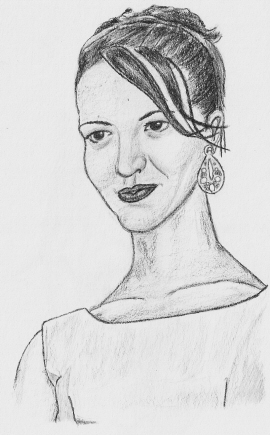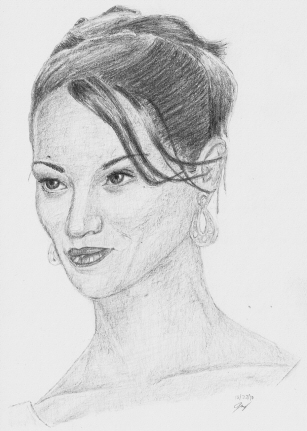|
“It might be wise to stick with an individual picture and sketch/render it multiple times (using different styles) to get a feel for the subject and how to draw it. It’ll also give me more practice at being consistent. We’ll see.” Six years later, I decided to give that idea a shot. So, I sat down and planned to do four drawings (all in the same sketchbook). Two grid transfers (one upside down, one right side up), and the other two freehands (again, one upside down, one right side up). And, as you’ll see, that didn’t quite go down the way I intended. First, I printed out two copies of the source photo (you can see it in the last picture at the bottom.) Then on one of them I used an orange Prismacolor pencil to superimpose one inch squares on top. I used orange because with the exception of sunrises and fires it’s one of the least seen colors in the spectrum (at least, for what I draw) so that keeps the grid visible. And when you draw lightly with a Prismacolor, you get a translucent effect so the under image is still somewhat visible. I left the other printout untouched for the freehand drawings. Anyway, the first render was the grid transfer. Now, this technique I had very little experience with at the time. I remember in my fifth grade art class, the teacher had us do a project utilizing grids, and I vividly recall myself and my friend Derek scoffing. We were the best artists in the class; everyone else thought we were great. So, the two of us finished first, and, in an act of defiance, also did a free hand version of the same project (which looked better.) That’s right. We were real artists, damn it, and didn’t need these juvenile gimmicks. Bah! (Note: Thank God I don’t have any drawing from back then ... looking at my stuff since the early Dark Side material thirteen years ago, I’m afraid ... very afraid.) Years later, I started (and abandoned) a series of drawings for Dark Side where I’d experiment with grid transfers. Got three done. That was basically it as far as experience with the technique. Despite that, I actually really liked how my grid transfer of an Asia Argento publicity photo came out. Using this technique helped me analyze and process the shapes/lines around the eyes, nose, and mouth. I’ve read about relationships of facial features in more than one book in the past, but for some reason it never fully clicked until I did this series of drawings (in general) and this grid transfer (in particular.) Starting with this drawing, I’d deliberately leave the grid lines in the background because I liked the effect and I don’t see the point of hiding the technique. Besides, I don’t see myself using grids for anything other than a means of warming up/studying an image the same way I use blind and speed renders to become familiar with the subject.
Next, I drew the freehand upside down render which is easily the worst. It had been a long time since I’d drawn upside down, and I literally felt at war while rendering it. You see, the point of drawing upside down is to present the mind with an image it’s not used to seeing; you deliberately make it harder for the mind to write off the image. You see a face, the mind says “face”, and that’s the end of it. When you turn the image upside down, the mind has to take an additional fraction of a second to process it, and then a “face” becomes “lines, shading, and highlights which make up eyes, nose, mouth, chin, et cetera.” My mind did not want to surrender its expectations; it fought tooth and nail trying to whip out the stamp and write the photo off as just another face, and to hell with the details. Anyway, I switched over to my smaller 5X9 sketchbook for reasons I’ll go into later. Continuing on to the best in the series: the free hand right side up. It’s obvious this is the medium and the technique I’m most comfortable with, and being third in the series I’d, by this point, learned from a few prior mistakes (such as avoiding thick goofy lines) and being third in the series, it meant I’d studied the source image longer and could make better sense of the indistinguishable dark areas in the source printout (notice the clearer details in the eyes and the perhaps overly-defined regions of her hair). Earlier, I mentioned how a lot of pointers I’d read about finally clicked, and here you can see a much greater awareness of the construction of the face and neck—muscles, over the bones, pulling on the skin to form facial expressions. Also a better sense of depth, volume and proportion. Unfortunately, I don’t recall the exact pencils used to do these renders (I’m writing and uploading this four months later.) I can say I used good art supplies, a hard lead pencil and a soft lead (probably didn’t go any higher than a 4B. I tend to avoid going too dark in the smaller sketchbooks for fear of smudging.) Anyway, since I once again returned to the 5x9 sketchbook, I decided to focus on drawing just Asia’s face so I could make it larger on the page (which gave me more room to work with subtle details.) And here’s where I got off track from my plan. You see, I actually started the second grid-transfer drawing in the 9x12 sketchbook. I got the initial lines down, the grid lines erased, and even did some preliminary shading. And I just lost interest. So I packed up my sketchbook and figured I’d come back to it. I never did. Hence why the two free hand versions appear in a different sketchbook. After over a month, I abandoned any thoughts of ever finishing the second grid and just moved on to the next page, the next drawing, the next source.
However, late one night, I couldn’t sleep despite being tired, and as I lay in bed I rolled over and saw the large dark shape that is my easel with the large drawing pad. It had been forever since I’d worked in charcoal, and charcoal drawings generally come out faster than pencil, so I figured I’d take a crack at it with this series. Unfortunately, even though I’ve had the easel for years, I rarely used it (all the charcoal stuff before I did on a flat table) As a result, this render represented many firsts for me: 1. Finding a comfortable position to draw from (new stool, felt obligated to sit in it; a mistake, it’s more comfortable and natural to stand). 2. Finding a place to put up my source image so I could easily reference it (clipped it to the curtain; another mistake, now I tape it directly to the easel). 3. The light source was behind me so I kept casting a shadow on the page (it was late, I was tired, so it never dawned on me to turn the damn thing so the light was perpendicular to both me and the sketchpad). 4. At that time, I still kept all of my charcoal drawings in the drawing pad, which meant I was drawing on top of all my previous renders, which, made me wary of smudging and ruining them (now I have a portfolio to keep completed renders separate.) So, yeah, I wound up making a lot of mistakes that I really shouldn’t have made. Oh well. At least I can say I’ve slept since then and have since found common sense remedies for every single issue. All in all, this series represents more than just six years of improvements, but in a way it also represents the start of a more serious approach and dedication to the medium. Long before Dark Side of the Soul, drawing was something I did for the hell of it. A hobby at best, maybe even a meaningless activity to kill time. And even across the eight years Dark Side has existed with its sparse updates and eternal repetitions of the phrase “I haven’t touched a pencil in X months” it never evolved much beyond that. And, at the risk of sounding overly dramatic, for me this series represents the last page of one chapter, and the first of a new one. I draw regularly. Upside down, right side up. Grids and freehand. I draw often from instructional books, and also from my ever-growing library of pictures—screen grabs from movies, professionally shot photos of an array of subjects. And despite the drastically increased productivity, the number of Dark Side additions remains sparse largely because I don’t feel I have anything to say about them—I feel like they can stand on their own without a long winded narration from me. Before, many additions were unique because they represented pretty much the only thing I worked on at the time; now, however, that one drawing doesn’t seem so special anymore considering I work out of three sketchbooks (not counting doodles which I still do on printer paper with a mechanical pencil.) This series will be special to me (even if I really don’t like two of the drawings that came from it) because it planted the seeds of so much of my current methods, and it’s very rare when you can definitively trace so much positive influence back to a single project.
—Jay Wilson Six Years Earlier: Asia Argento, Take One |
|
|



